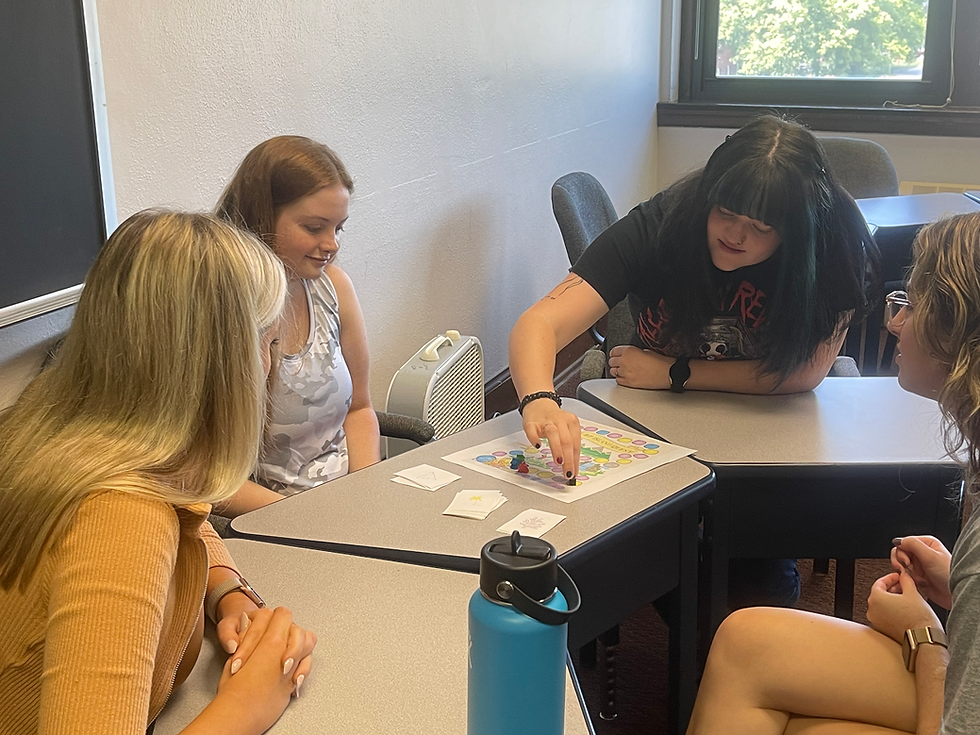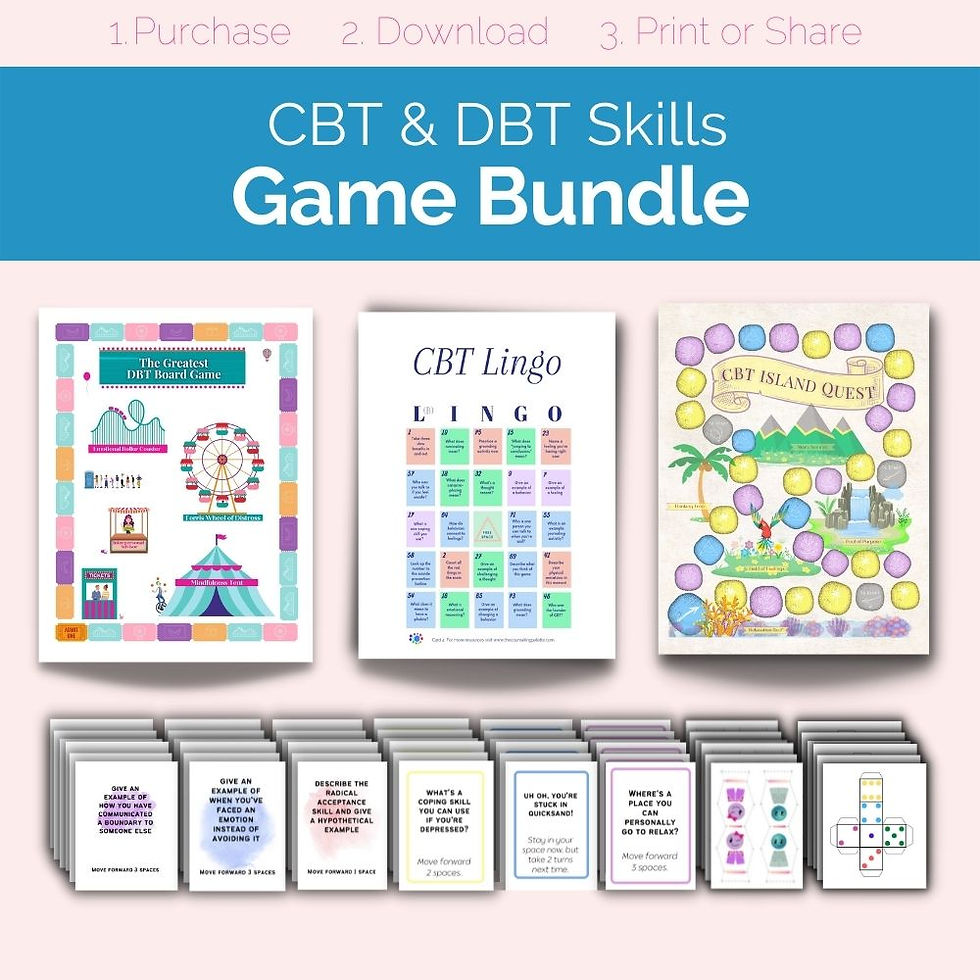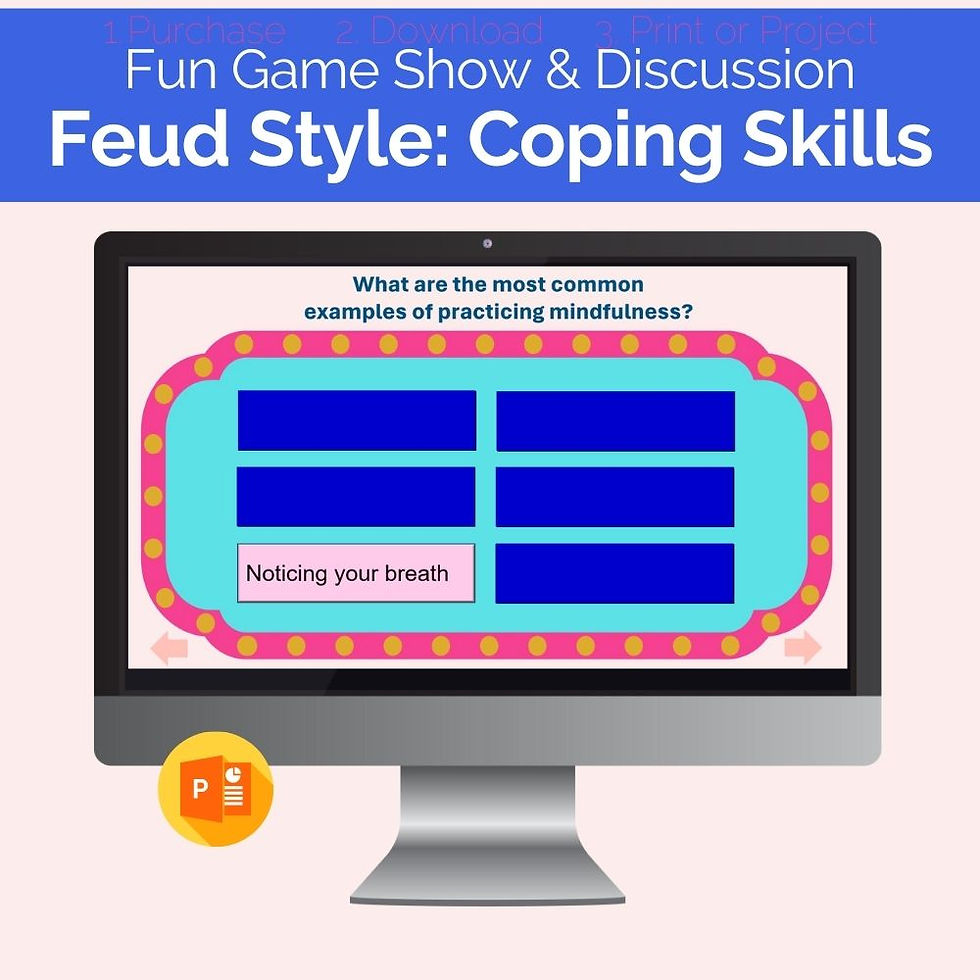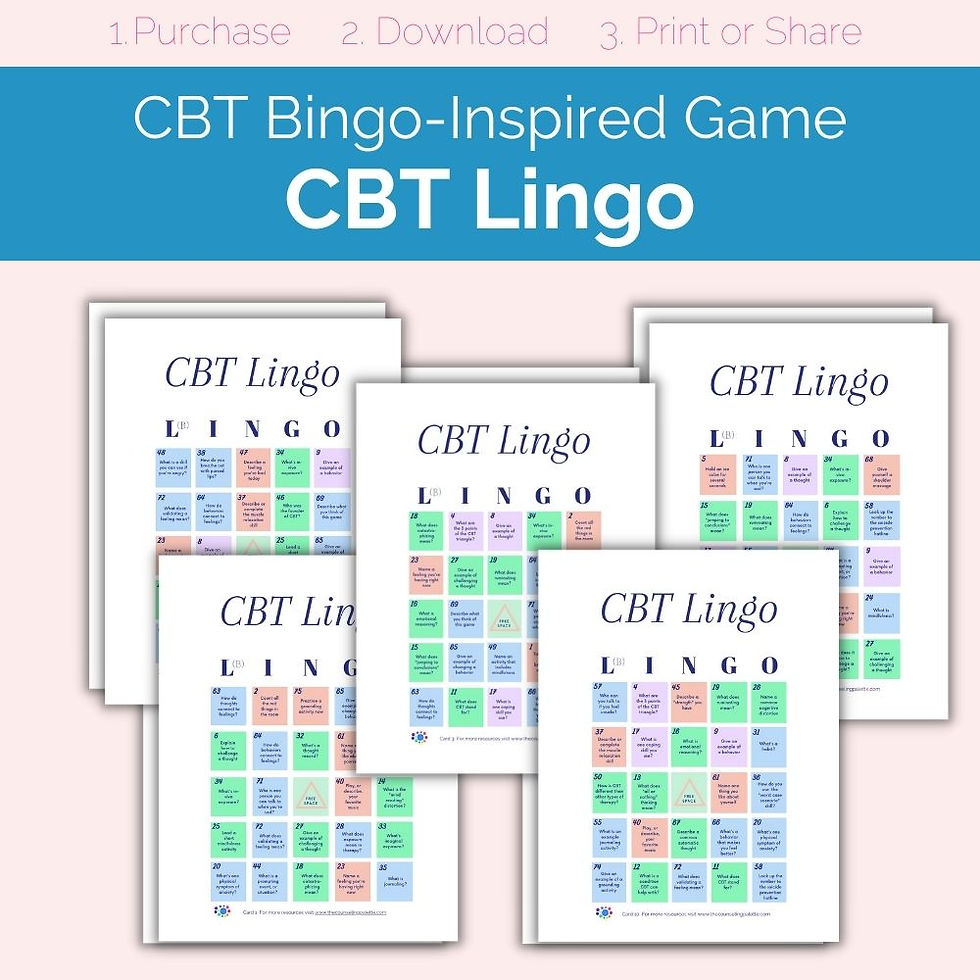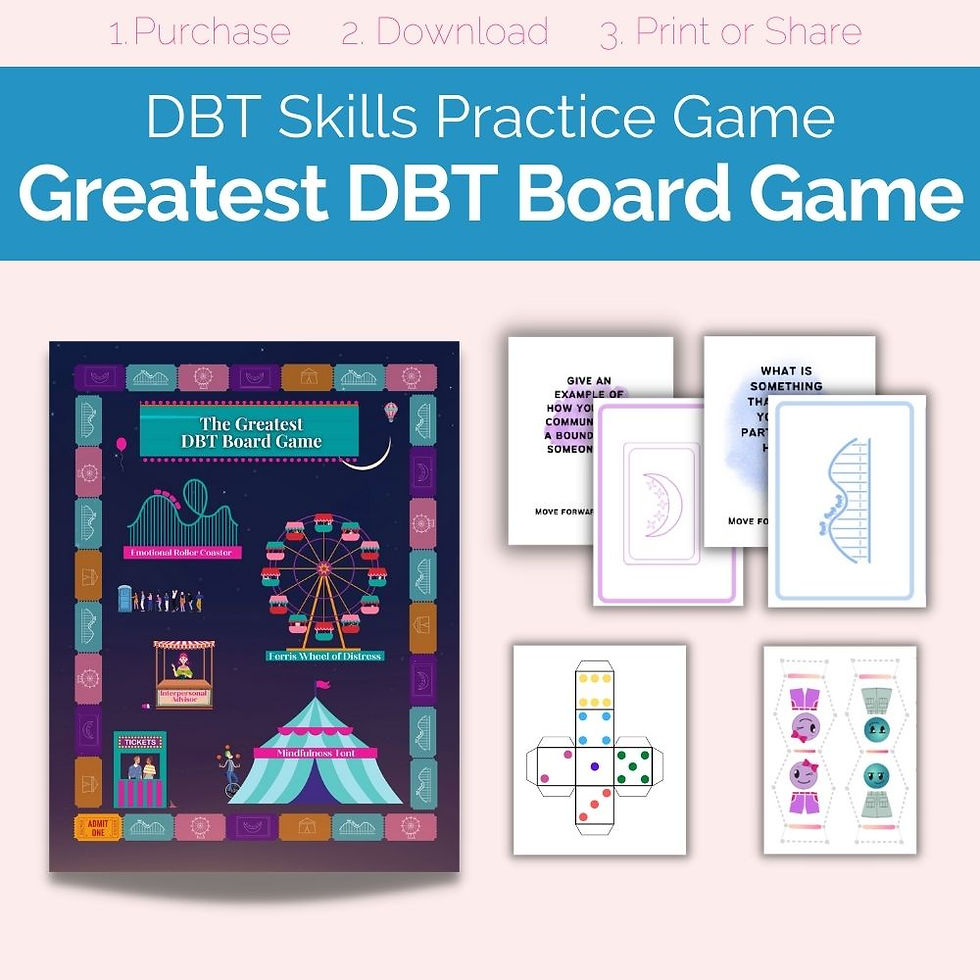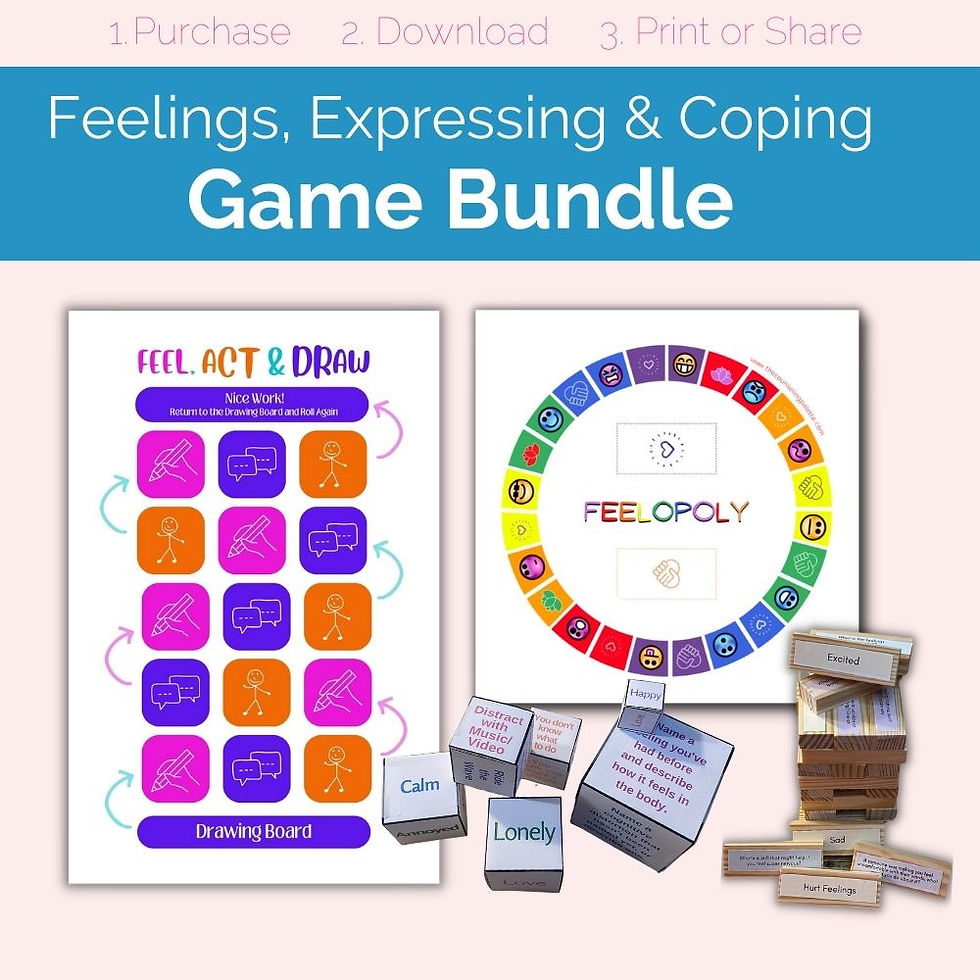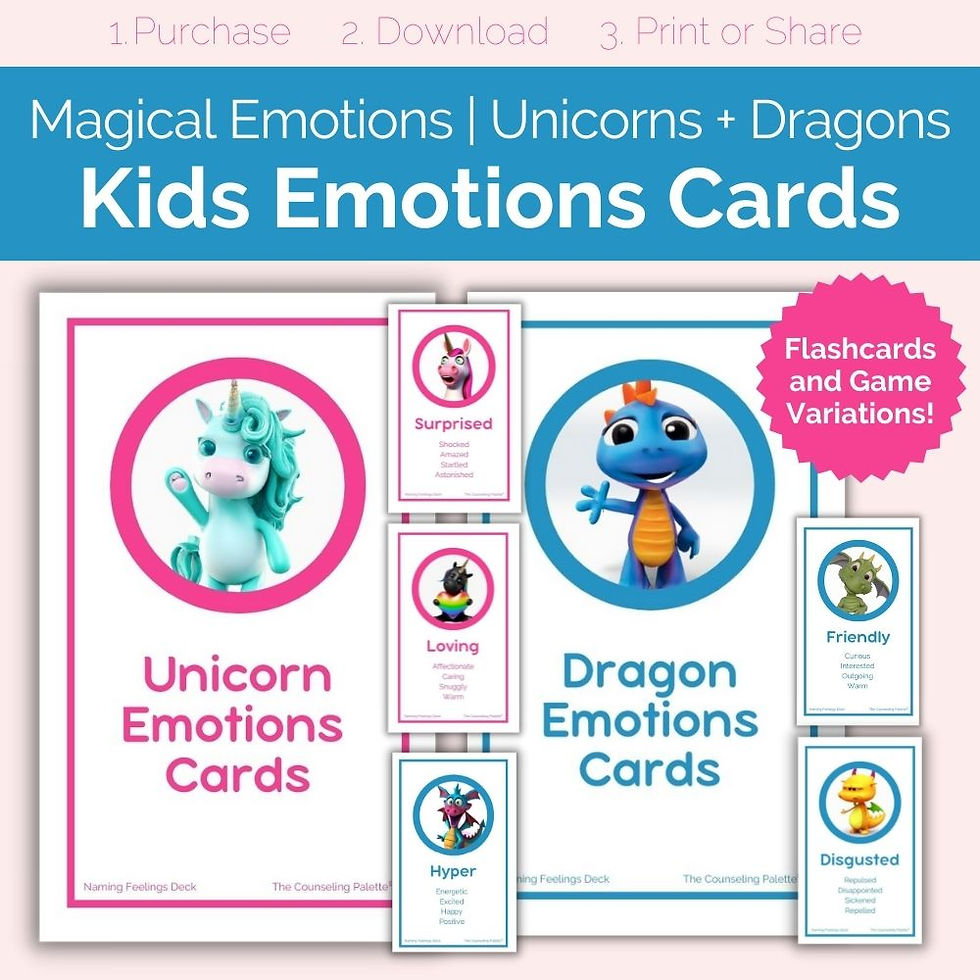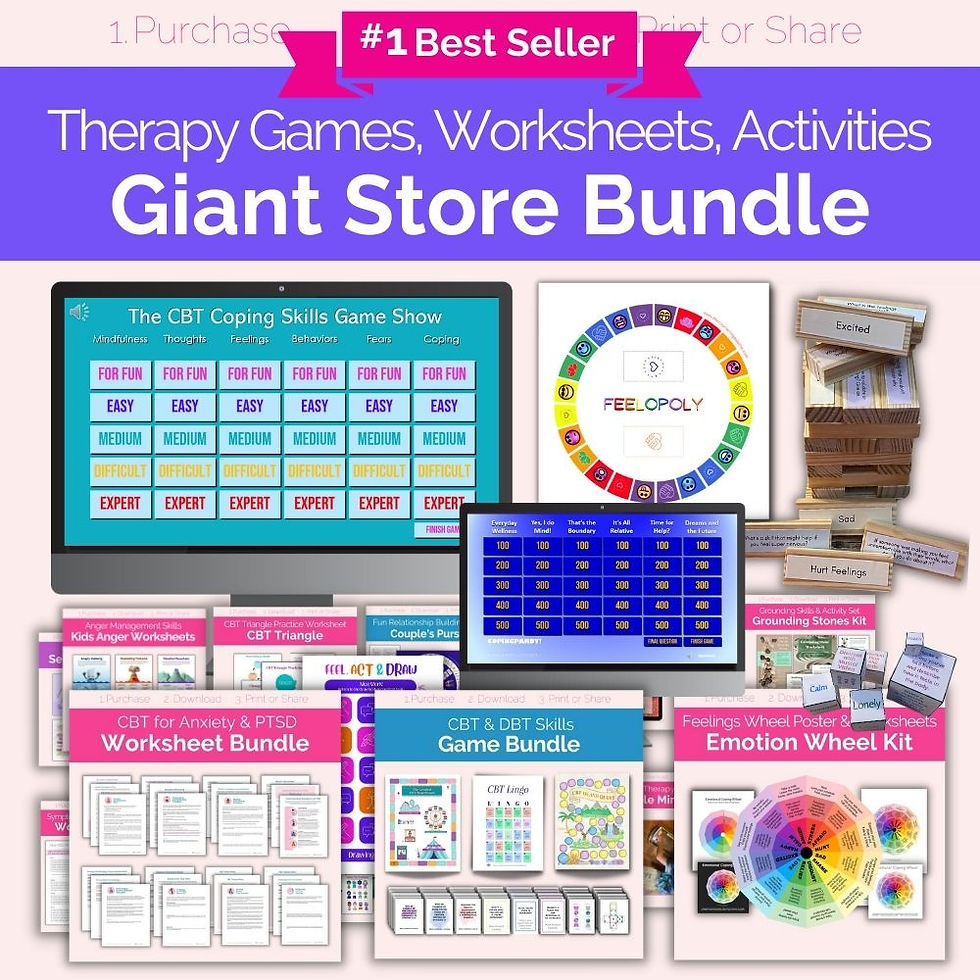Therapeutic games can help build rapport and teach important concepts like coping skills.
Therapy games make therapy less intimidating, more enjoyable, and even more effective. Studies show that kids and adults learn better through play (Yenigen, 2014).
Play is often encouraged as a way to treat symptoms in therapies like trauma-focused CBT (Allen et al., 2017). It can be used for many purposes, modalities, and settings. Here are some examples:
Teaching CBT
DBT skills groups
Play therapy
Hospital settings
Community group therapy
Problem solving groups
Anger management groups
Classes and student groups
Individual therapy sessions
As a community therapist, I found games made sessions with new teens less awkward, helped get groups of all ages more involved, and were a life-saver when I had minimal prep time.
Games are also great for getting to know your clients, and for teaching important concepts like coping skills and understanding emotions. They can work with kids, teens, families, groups, and adults–in person and during telehealth.
Some of the most fun and easiest games to play with clients are therapeutic board games. Many include discussion or learning prompts, and cover topics like feelings, cognitive behavioral therapy (CBT), or dialectical behavioral therapy (DBT).
Since the games are usually structured and straightforward, they may be less intimidating than regular talk sessions. You can use these tools as a way to
teach concepts, to review skills, or just to have fun and get to know each other.
Below are some fun and effective therapy games that may leave a lasting memory for you and your clients. Several options are printable PDF downloads. All are evidence-based and focus on developing and practicing skills.
1. Coping Skills Quiz Show for Teens & Adults
Great for: Teens, adults, schools, adult education, telehealth
Works with: Individual therapy, groups, in-person, telehealth
Goals: Positive self-care, mindfulness, boundaries, coping skills, goals
This coping skills Jeopardy-type game show is created to be fun and interactive. This version is designed for teens and adults (see a kid-friendly version for all ages below, or get them both in the bundle). It includes discussion prompts as well as some tips in each category and several hands-on group activities such as creating individual coping strategies.
The quiz show includes six categories including:
Wellness
Mindfulness
Boundaries
Relationships
Asking for help
Setting goals
The best way to play the game is to project it in presentation mode through PowerPoint. It includes fun music and even applause options so it has a real Jeopardy game type feel. You can click through the links and move around like in a live show. If you don't like PowerPoint there is a simpler PDF option included.
Learn more, or get it as part of the giant store bundle.
2. CBT Coping Skills Game Show for All Ages
Great for: Kids, teens, young adults, adults
Works with: Individual therapy, groups, in-person, telehealth
Goals: Coping skills, thoughts, feelings, behaviors, mindfulness
If you're looking for a game for any age, including kids, check out this CBT coping skills Jeopardy-inspired game. I've had feedback that it worked well for third graders as well as adult nursing classes, so you can make it your own!
This edition has all different prompts compared to the teen and adult version, but does overlap in categories. Topics covered include:
Mindfulness
Thoughts, feelings, & behaviors
Identifying emotions
Changing thoughts
Facing fears
Coping planning
The mental health game has open-ended prompts so your discussions can adapt based on your group's needs. Having some CBT knowledge is helpful, but you can also slow it down and use it as a way to teach new skills and techniques.
It's an easy low-prep activity for a group or classroom, social emotional learning, group therapy, teletherapy, and more. Learn more.
3. FEELOPOLY Emotions Game
Great for: Kids, tweens, teens, some adults and young adults
Works with: Individual therapy, groups, in-person, telehealth
Goals: Naming emotions, expressing feelings, validating emotions
FEELOPOLY is one of the most popular therapy games and mental health downloads available online.
It's a creative and fun emotions game. Rather than working against each other like in a Monopoly game, FEELOPY has the team working together. The goal is to work as a taskforce to "validate" all of the feelings on the board.
It covers concepts of naming feelings, validating emotions, expressing emotions, and communicating experiences. Example prompts include:
Do you have an outlets for your feelings? What's one way you express them?
What might help if you're starting to feel frustrated?
Explain how a trigger might bring up a feeling. Give an example.
The game is a PDF printable which you can start using right away. I recommend assembling it as a group with your clients. You can check out FEELOPOLY and download it here.
4. CBT Island Quest
Great for: Kids (11+), teens, college students, families, some adults
Works with: Groups, in-person, telehealth
Goals: Learning or reviewing CBT concepts, practicing coping skills, building confidence
CBT Island Quest is a straightforward printable therapy game of discussion and prompts. Players roll or use the card instructions to move around the game.
Prompt cards are divided into mindfulness/relaxation questions and cognitive questions. Example prompts include:
You think your friend is mad at you because they cancelled your plans together. Challenge the thought.
What's a coping skill you can used when you're depressed?
What does it feel like in your body when you're relaxed?
5. Family Feud Inspired Therapy Game
You might find something soothing about Family Feud, whether you grew up watching it or enjoy the new Steve Harvey version. This fun Family Feud style therapy game reviews overall wellness, mental health, and coping skills.
Each category includes wellness-related questions with six common answers on the board. Teams (or individuals) can also earn partial points for skills or helpful answers not on the board.
Each board is followed by a more general discussion question for the group, and players can earn bonus points for participation. Categories include mindfulness, anger management, dealing with anxiety, overall wellness, and more.
The coolest part of the game is that it’s designed in PowerPoint and has fun interactive elements that feel like a real game show. The therapist or leader plays the roll of “host” and reveals the answers when guessed, or at the end of the round.
6. CBT Lingo (CBT Bingo)
Great for: Kids (11+), teens, college students, families, adults (adaptable for skill level/age)
Works with: Groups, in-person, telehealth
Goals: Learning or reviewing CBT concepts, psychoeducation, practicing coping skills, test review
This printable game is focused on teaching CBT theory and coping skills. It includes rule variations based on your goals, the group’s experience level, and age group. It’s based on, and playable, with a real Bingo set.
Rather than just a novelty game like many therapy bingo pages, it actually includes 10 unique playing cards and 75 prompts relating to CBT. It’s great for groups, telehealth, and individual clients in-person or online.
Some of the prompts include:
What is an automatic thought?
Draw a feelings thermometer
Name a common cognitive distortion
What are the three parts of the CBT triangle?
7. DBT Board Game
Great for: Teens, young adults, college students, anyone familiar with DBT skills
Works with: Groups, in-person, telehealth
Goals: Learning or reviewing DBT concepts, practicing the four areas of DBT skills
The Greatest DBT Board Game uses a fun carnival theme to make reviewing DBT fun and entertaining. It covers the four areas of DBT skills, including mindfulness, interpersonal effectiveness, distress tolerance, and emotional regulation.
Files are printable and come as PDFs.
Example prompts include:
Give an example of using opposite action to change an emotion
Think of a time you've used radical acceptance. Did it help you? Why or why not?
Describe a rude way to ask for help, versus a more effective way.
The game throws in fun elements, such as the "Emotional Roller Coaster," and the "Ferris Wheel of Distress."
8. Couple's Pursuit
Great for: Adults, couples
Works for: Couples homework, possibly couples sessions
Goals: Building relationships, practicing communication, expressing affection
Do you work with couples, or are you looking for a fun way to improve or build on your relationship? Couple's Pursuit is an activity-based relationship game that includes fun categories like drawing and guessing, along with discussion topics, prompts to express appreciation, and more.
It's inspired by Trivial Pursuit, however rather than trivia questions the categories cover important relationships skills. It includes categories that focus on skills used in popular therapies like the Gottman Method. Examples include:
Showing affection
Friendship and bonding
Shared goals
Fun and recreation
9. Therapy Shuffle
Great for: Older Older kids, teens, adults, families, groups
Works with: Groups, in-person
Goals: Learning or practicing coping skills, problem-solving, teaching concepts, building rapport
Therapy Shuffle is a therapeutic card game inspired by Fluxx, although it's slower-moving and based on coping skills. The game is complex enough to keep many teens and adults engaged.
Players choose "goals" and collect "skills" to match the goal cards. Players have to answer coping-skills related prompts to be able to play their cards and win.
The game can be played competitively or cooperatively, depending on your group. If you like you can also scrap the prompts, and play the cards as is. Learn more and download the therapy card game here.
10. Feelings Block Games
Great for: Kids, teens, adults, families, groups
Works with: Groups, in-person
Goals: Learning or practicing coping skills, understanding emotions, teaching concepts, building rapport
Stacking tumbler block games are popular among therapists–especially those who work with kids. It’s a particularly easy one to set up. You can write a prompt on each block, or add a color using markers or stickers.
You can also print out prompts on sticky paper and stick or tape them to the blocks.
Sometimes the blocks are also color-coded. For example, a blue block might correspond to happy feelings. A player might then discuss a time recently that made them feel happy, or what it was like to feel that way. Or, blocks can be numbered and correspond to discussion prompts.
Some of the generic tumbling blocks actually come in various colors, making it easy to set up color-based categories for the game. This also works with other colorful games like pick-up sticks.
Here are some example prompts:
Imagine you go so angry that you felt like throwing something. Do you think it would help? Is it safe to do?
Describe what a feeling (ie sadness) feels like in your body.
What should you do if your feelings are overwhelming you.
11. Feel, Act, & Draw
Great for: Teens, young adults, college students, families
Works with: Groups, in-person, telehealth
Goals: Discussing feelings, interaction, ice-breaker
Feel, Act & Draw is a mental-health version of games like charades and Pictionary.
Players round a game board while they either answer discussion prompts or draw or act out feelings scenarios. For example, if a player lands on a charades space, they might act out the feeling "sad" or the scenario "mad at my friend."
If they land on a drawing space they sketch it out, Pictionary style. And if they land on a discussion space they talk through the questions in a more traditional style. Download and print it here.
12. Cube or Dice Prompts
Great for: Kids, teens, adults, families, groups
Works with: Groups, in-person, telehealth
Goals: Learning or practicing coping skills, responding to prompts, building rapport
You can play this game with dry erase blocks, real dice, or any empty square box. Or, print these paper dice with prompts and tape them together.
Assign your own prompts to each side of the cube, or assign a corresponding question to each number on the dice. You can even use a dice app on your phone if you prefer, especially for telehealth.
This game is highly customizable, but here’s an example:
Let’s say you want to review DBT skills. Each side of the box would include a prompt such as “Name a skill to try when you feel angry.”
Someone throws the block across the ground, and then must respond to the prompt that lands face-up in order to get a point.
If you’re using real dice, then each number would represent a corresponding prompt you have written down. So if someone rolls a “2” they would answer the question you have prepared for #2.
This is great for clients who need to move around a lot, or for a group that’s getting bored. You can also use the paper dice as an activity, or send it as homework or an assignment for telehealth. Check out the pre-printed blocks here.
13. Emotions Match
Great for: Kids
Works with: Individuals, groups
Goals: Identifying and naming emotions
Emotions Match, inspired by the traditional Match Game, helps kids match up expressions and body language with the names of feelings. For example, one card has an image of a character who looks happy. The matching card has the word "Happy" on it.
Check out this printable match game which comes in a set with several variations. If you like, you can use just the emotions, or use two copies of the traditional feelings cards.
14. Happy Dragon
Great for: Kids
Works with: Groups, classes
Goals: Identifying and naming emotions
The Happy Dragon emotions game is inspired by the unfortunately-named "Old Maid" game. However, players are trying to end up with the Happy Dragon to win, versus lose (as in the other game). The game uses feeling-words cards, so players are exposed to emotions vocabulary. You can also add emotion prompts to encourage discussions about feelings.
15. Go Feel!
Great for: Kids, families
Works with: Individuals, groups, family therapy
Goals: Identifying and naming emotions, discussing feelings
Go Feel is based on the beloved game Go Fish, so the mechanics are easy to catch on to. Players aim to collect and match emotion cards. This helps provide them with exposure to feelings words and images. Discussion prompts can also be added to deepen the game.
To play Go Feel you need multiple matching emotion cards. Check out this download to get started.
16. Family Pursuit
Great for: Families of all kinds
Works with: Family sessions, family homework
Goals: Communication, coping skills, showing appreciation, decreasing conflict
If you're looking for a fun family therapy game, check out Family Pursuit. It's similar to Couples Pursuit, but with new categories that are focused on bringing families together. Question categories include:
Learning about each other
Discussing positive memories
Showing appreciation for each other
Famous families trivia
Family coping skills
It's a great way to practice communication and feel closer without feeling as much pressure. It can be special for young kids and a way to coach teens into sharing more. Learn more.
17. Stop, Relax & Think Game
You can purchase Stop, Relax and Think on Amazon. It's a popular game often used in therapies like trauma-focused cognitive behavioral therapy (TF-CBT) to help teach emotional regulation.
The game is appropriate for kids working on anger outbursts, but may be able to help with other impulsive behaviors as well. It covers multiple coping skills, including of course the "stop, relax, and think" steps. Find it on Amazon.
18. The Talking, Feeling, & Doing Game
The Talking, Feeling, & Doing game has been around for years. It was created to help break down barriers in therapy, so children can feel more comfortable to open. Prompts vary from more basic questions to deeper ones about life history. You can get the game here on Amazon.
19. The Skittles Game
Candy sure makes it easier to talk about feelings! This game uses candy of various colors, like Skittles or M&Ms, to prompt discussion. You can use any number of prompts and activities. For example, you can divide the colors by feelings, coping skills, or mindfulness activities.
When a child chooses a color, they must answer the prompt. Then they get to eat the candy! You can imagine why this game would be popular.
20. Therapy Uno
Did you think I would skip Uno? (Actually I did and added it later.) Uno is played similarly to the Skittles game. When a player changes the color being played, they describe a type of feeling, or answer an assigned prompt.
You can play many games that involve color this way as well, such as pick-up-sticks, or color-coded tumbling blocks.
21. DIY Therapy Cards
Using a set of blank cards, or standard playing cards, add your own prompts or activities to the cards. For example, each “set” earned in traditional Go-Fish would require the player (or all players) to name a feeling word.
You can combine the prompts with a traditional game, or simply take turns drawing a card and following the prompt.
If your client is up for it, they could also create their own cards for therapy. They might list feeling words or coping skills, and act them out each time the card comes up. This version may work better for telehealth–your client can be in charge of the cards on their end.
In family therapy, you might play where each person who wins a game or scores a point gets to ask a question of another player that wouldn’t normally be well received.
For example, a parent might ask a teen why they always shut their bedroom door when they get home, or a child might ask why they never get to stay up late on weekends. The other player can earn their own point if they answer, or they can pass.
Your clients can help make up the rules of the game, as long as it involves responding to prompts at least part of the time.
22. Taboo
Family board games can be therapeutic all on their own. Or, you can add prompts to add more depth. For example, replace Taboo cards with your own feelings or skill-based prompts. Perhaps you have to describe the feeling of anger only using physical sensations, while the other person guesses the emotion.
23. Connect-4
You may not imagine it, but when I worked with kids Connect-4 was probably the most valuable game in my office. We didn't add therapy to it at all. But the easy physical actions of the game (and simple rules) made it easy to chat while we played.
I learned all kinds of things about a child or teen's day, family, and relationships. Just keep it near your desk or in sight, and ask your client if they'd like to play. I don't think I was ever turned down.
24. Candyland
For younger kids, Candyland can be a great teaching game. You can simply play the game as is to build rapport. Or, you could talk about feelings depending on where the child lands. Having to return to the beginning is a perfect chance to talk about feelings.
25. Trivial Pursuit
The traditional Trivial Pursuit can be conveniently adapted to therapy. Simply replace the categories and make them about concepts you're learning, such as CBT skills. Or, make each space a prompt, such as discussing a feeling.
26. Ungame
Ungame is a popular card game used in therapy. It has board game and card game versions. You can choose card prompts that are appropriate for your client. There are different levels depending on the type of topics you want to discuss. You can get the game here on Amazon.
27. Relationship Skills Card Game
This versatile game focuses on issues like social skills, conflict, and empathy building. It includes conversational prompts, icebreakers, and more. It's great for adult groups or even work settings. Check out the Relationship Skills Card Gamecards on Amazon.
28. Mindfulness Game
The Mindfulness Game is a detailed card deck with multiple activities for individuals and groups to follow. It's designed by teachers with specific activities and clear instructions. It's one of the older and most popular prompt decks. Check it out here.
29. Minecraft
Do you even know a kid who doesn't like Minecraft, even if they don't get to play it? Older kids and teens often find this game captivating. The good thing is that parents can play the game with kids, providing a modern bonding activity. During session, kids can show you what they've built and discuss what they like about the game. If you have trouble getting a tween to talk, it might be the ticket in.
30. TF-CBT Triangle App
The good folks who developed and teach TF-CBT therapy partnered to offer a fun app that helps teach basic CBT skills. While it's created as a part of the trauma therapy, it doesn't get into any trauma prompts or exposure techniques. It may be appropriate to teach the CBT triangle to younger kids. You can learn more here.
31. Creative VR Games
If you've never been inside a VR world, I encourage you to try it at least once. There are some pretty cool creative games, such as Tilt Brush by Google. If a client wanted a world where there was endless creativity and literally no physical limits, this would be it. It may be a very helpful art therapy or creative expression tool in the future.
32. Escape Rooms
Escape rooms are a great way to learn to work together in tight spots, so to speak. You don’t have to go to a literal escape room – there are kits online where you can set up your own scene and mystery. You can use them with kids, teens, adults, and even for workplace team building.
33. Scattergories
You might vaguely remember Scattegories from your childhood – it’s that game where you get a list of prompts and you try to come up with unique words that start with the same letter. You can create the same game but use therapy prompts, such as coping skills that start with T, or self-care techniques that begin with S.
34. Sports
If your client or group loves sports, try incorporating it in therapy. For example, you and your client could play HORSE with a basketball while you discuss the week. Even nerf games in your office can be a great icebreaker.
35. Roleplaying Games
Games like Dungeons and Dragons, and various other role playing games you can find online, provide a safe outlet for expression. Create your own scenario, or let your client take the lead if they’re familiar with the idea.
Play Around!
There really is no limit to using games in therapy. The flexibility of games can work great with telehealth. Ask the client what games they have at home.
Then they can run the game from their side, and you can provide the prompts. You may not even need a copy of the game to play from your side, depending on how complex it is.
Don't be afraid to experiment with new ideas and activities, whether you're in person or connecting via Zoom therapy. At the very least, any game used in therapy can help promote rapport with clients. They can also be a great way for groups and family members to bond.
Games might not seem like serious business, but with many clients they’re likely to get you further than traditional sitting and talking therapy sessions.
Want some easy games and activities to download use with your clients? Check out this great therapy game kit to get started, or fill your toolbox to the bring with our Entire Store Bundle.
-Jennie Lannette, MSW, LCSW, is a licensed therapist specializing in anxiety and PTSD. She has experience running therapy groups in schools, hospitals, and community settings.
-Games listed from Amazon include a small affiliate income if you make a purchase through this site.
Sources
Allen, B., & Hoskowitz, N. A. (2017). Structured Trauma-Focused CBT and Unstructured Play/Experiential Techniques in the Treatment of Sexually Abused Children: A Field Study With Practicing Clinicians. Child maltreatment, 22(2), 112–120. https://doi.org/10.1177/1077559516681866
Yenigen, S. Play Doesn’t End in Childhood: Why Adults Need Recess too. NPR. https://www.npr.org/sections/ed/2014/08/06/336360521/play-doesnt-end-with-childhood-why-adults-need-recess-too



































































